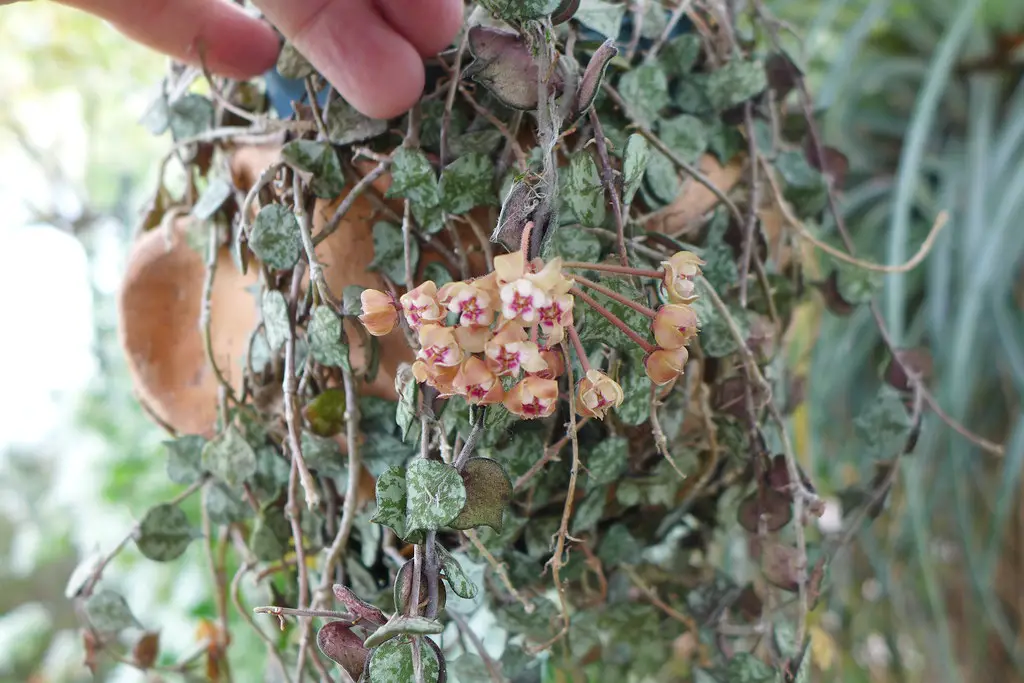Hoya Curtisii is a captivating plant that’s known for its attractive foliage and distinctive appearance. Native to the Philippines, Thailand, and Malaysia, it features small, oval-shaped leaves adorned with silver specks, giving the plant an almost magical appearance. The trailing growth habit of Hoya curtisii allows it to be used in hanging baskets or placed on shelves, where the vines can beautifully cascade down.
One of the remarkable aspects of Hoya curtisii is its flowering capability. The plant produces small, delicate clusters of star-shaped flowers that offer an exquisite fragrance. These blossoms add to the plant’s aesthetic appeal and make it a sought-after choice for houseplant enthusiasts.
Although Hoya curtisii is beautiful and unique, it is also known to be somewhat finicky, especially when it comes to care. Specific requirements regarding lighting, watering, and soil need to be met for the plant to thrive. Understanding and providing these needs can lead to a healthy and thriving Hoya curtisii, a showstopper in any indoor plant collection.
| Attribute | Details |
|---|---|
| Common Names | Hoya Curtisii, Porcelain Flower |
| Botanical Name | Hoya curtisii |
| Family | Apocynaceae |
| Plant Type | Evergreen Perennial |
| Mature Size | Up to 4 feet |
| Sun Exposure | Bright, indirect light |
| Soil Type | Well-drained, peat-based soil |
| Hardiness Zones | 10-11 |
| Native Area | Philippines, Thailand, Malaysia |
Hoya Curtisii Care
Caring for Hoya curtisii requires careful attention to its specific needs. It demands a certain level of humidity and consistency in watering, along with bright, indirect sunlight. The proper soil mixture is also vital to ensure that it receives the nutrients it requires without retaining excess moisture.
Potting in a well-draining container is crucial as the roots of Hoya curtisii are susceptible to rot if left in waterlogged soil. Regular monitoring and timely adjustments to care can lead to a thriving and attractive Hoya curtisii, rewarding the gardener with its charming appearance and delicate flowers.
Light Requirement for Hoya Curtisii
Bright, indirect sunlight is ideal for Hoya curtisii. Placing it near an east or north-facing window often provides the perfect amount of light. Too much direct sunlight can cause leaf scorching, while too little can lead to weak growth and a lack of flowering.
Soil Requirements for Hoya Curtisii
Well-draining, peat-based soil with added perlite or sand is best for Hoya curtisii. Good drainage is essential to prevent root rot, but the soil must also retain some moisture to keep the plant happy.
Water Requirements for Hoya Curtisii
Hoya curtisii prefers the soil to dry slightly between watering. Over-watering can lead to root rot, while under-watering can cause the leaves to dry and wilt. Establishing a consistent watering routine, adjusted according to the season and the plant’s needs, can be crucial for success.
Temperature and Humidity
Hoya curtisii enjoys temperatures between 60-80°F (15-27°C) and appreciates higher humidity levels. Regular misting or placing the plant near a humidifier can help maintain the moisture it needs, especially during drier periods.
Fertilizer
A balanced, water-soluble fertilizer applied every four to six weeks during the growing season (spring to early autumn) is suitable for Hoya curtisii. Be cautious not to over-fertilize, as this can cause harm to the plant.
Pruning Hoya Curtisii
Pruning Hoya curtisii is usually unnecessary unless shaping the plant or removing dead or damaged growth. Any pruning should be done with care, as excessive cutting can hinder the plant’s development.
Propagating Hoya Curtisii
Propagating Hoya curtisii is commonly done through stem cuttings. Select a healthy stem with at least one leaf, and place it in water or soil to root.
How To Grow Hoya Curtisii From Seed
Growing Hoya curtisii from seed is a more challenging method but can be done. Sow seeds in a well-draining medium, keep moist, and provide warmth and indirect light.
Common Pests & Plant Diseases
Mealybugs
Mealybugs can be a problem and may require treatment with insecticidal soap or neem oil.
Aphids
Aphids can be controlled with similar methods to mealybugs.
Common Problems With Hoya Curtisii
Yellowing Leaves
Yellowing leaves often indicate over-watering or poor drainage. Check the watering routine and ensure the soil drains properly.
Weak Growth
Weak growth may be a sign of inadequate light or nutrients. Adjust the plant’s location or fertilize as needed.
Pro Tips
- Ensure proper drainage in both pot and soil to prevent root rot.
- Maintain consistent watering but allow soil to dry slightly between.
- Provide bright, indirect sunlight for optimal growth and flowering.
- Watch for signs of pests and act quickly to prevent infestations.
- Be patient, as Hoya curtisii can be slow to grow and bloom.




